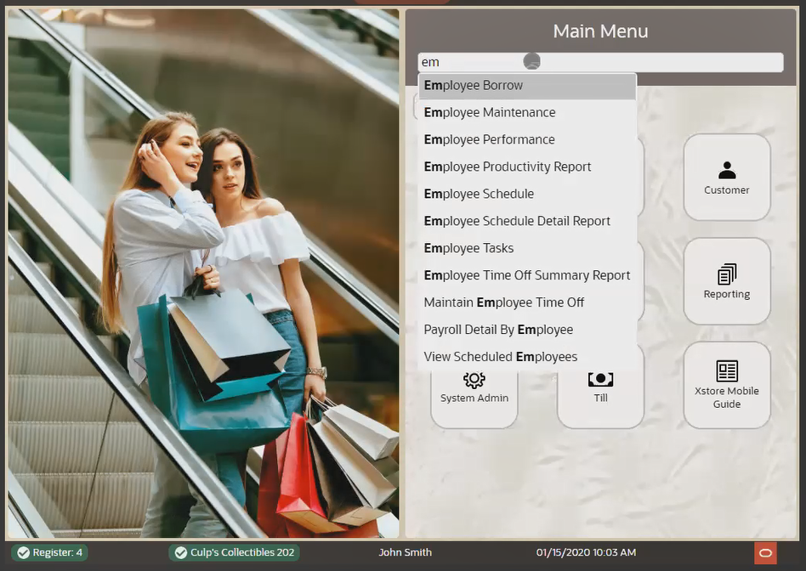2 Documentation and Screen Conventions
The interface for Xstore POS is made up of common elements. These elements include text fields, numeric fields, buttons, links, lists, and menus used to select options, enter data, or open new screens.
Select an element to learn more about its use.
Text Field
A text field is used for keying in information. When a text field is selected, an on-screen keyboard opens which you can use to enter the requested information.
Figure 2-1 Text Field with Keyboard Example
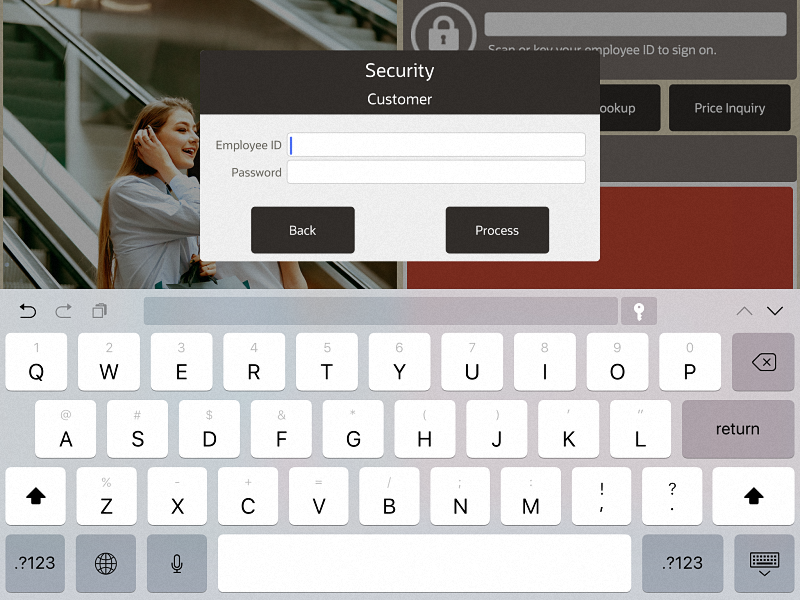
The appearance of the keyboard will depend upon the device on which you run Xstore POS. An on-screen keyboard is also displayed for alphanumeric entries such as login/passwords and postal codes.
Figure 2-2 Handheld - Text Field with Keyboard Example
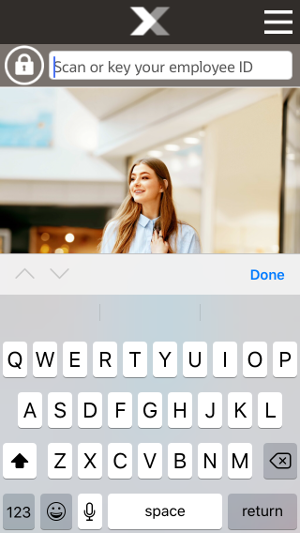
Numeric Field
Whenever a numeric entry is required on the Xstore Desktop, Thin Client, Tablet, or Handheld, a prompt displaying the field name is automatically shown. The prompt allows you to enter numbers as required.
Figure 2-3 Numeric Field Example

Upon completion of a numeric entry the prompt closes.
When a phone number entry field is selected, the phone number keypad displays automatically.
Figure 2-4 Handheld - Phone Number Entry

Buttons
By selecting a button on the screen, you select the action that button performs. Buttons can take many forms, depending on their use. Some menu buttons may not be available to every associate. Security configuration determines which options are available to an individual associate.
Table 2-1 Buttons
| Buttons | Description |
|---|---|
 |
Standard Buttons |
|
|
|
|
|
Item Lookup Button |
|
|
|
|
|
Back Button
The Back button is located on the top line of the screen and exits out of the current activity and returns to the previous activity. You are prompted whether to save current work before canceling an action. The text in a Back button may differ and the activity to which it returns depends upon its location in the application.
Table 2-2 Back Buttons
| Button | Text in Back Button |
|---|---|
|
|
Back button |
|
|
Cancel button |
|
|
Cancel Sale |
Quick Action Buttons
Different buttons provide quick access to functionality from either the Home screen or when you are in the Sale screen. These short cut buttons are available on Desktop, Thin Client, and Tablet.
Figure 2-5 Quick Action Buttons Home Screen

Quick action buttons when in the Home screen include the following functions:
-
Sale - Selecting the Sale button allows you to enter your login and password and then based on the configuration of the store, either prompt for sales associate and or prompt for customer and then take you into the sales screen.
-
Customer - Selecting the Customer button gives you quick access to the customers transaction history and not only opens the customer maintenance area but using the Context Menu, you can start a sales transaction with the customer already assigned to the transaction. Known as a Customer Journey, you do not need to exit the customer screens to begin a sale and re-attach the customer.
-
Item Lookup - Select Item Lookup to search for an item and learn its stock availability, even when the register is closed.
-
Price Inquiry - Scan or enter an item ID in Price Inquiry to give you the price of that item in an instant.
-
Engagement Activity - Requires integration with Oracle Retail Customer Engagement. Mainly for fashion retailers to track and capture activities pre transaction such as which items are tried on and the changing room used. From here you can convert to a sale or save to the wish list (items that a customer has expressed an interest in).
Figure 2-6 Quick Action Buttons Sale Mode
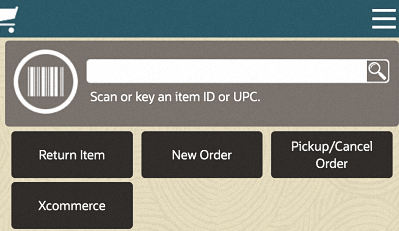
Quick action buttons when in the Sale screen include the following functions:
-
Returns
-
New Order
-
Pickup/Cancel Order
-
Xcommerce - See Xcommerce.
Context Menu
Note:
There is no Context Menu when using the Desktop user interface. This UI configuration is only on wide screen devices and all functions are displayed without the need of the Context Menu.
Figure 2-9 Context Menu Button
The Context Menu button will not be present on all screens. When it is present, the Context Menu button (touch icon) will always be in the upper-right hand corner of the screen and opens a context menu showing appropriate actions you can make.
The options in the Context Menu itself will depend upon the screen in which it is located. The options available are equivalent to the Function buttons shown on the desktop.
Examples of the Context Menu for the Xstore POS from the home screen are shown below:
Figure 2-10 Tablet Home Screen Showing Context Menu Options
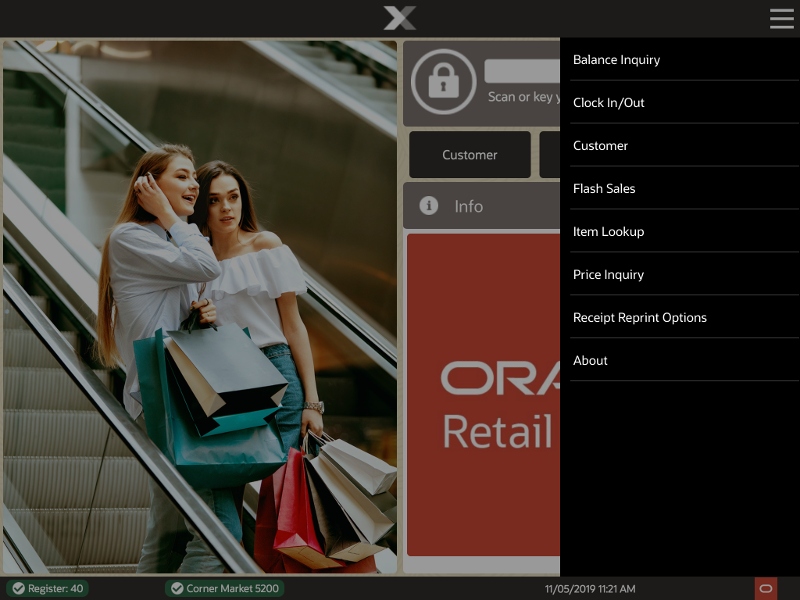
Figure 2-11 Context Menu on Handheld
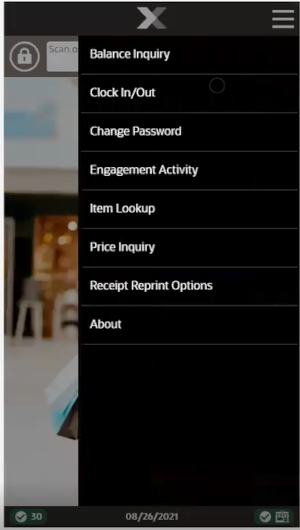
Examples of the Context Menu for the Xstore POS from the sales screen are shown below:
Figure 2-12 Tablet Context Menu - Sale Mode
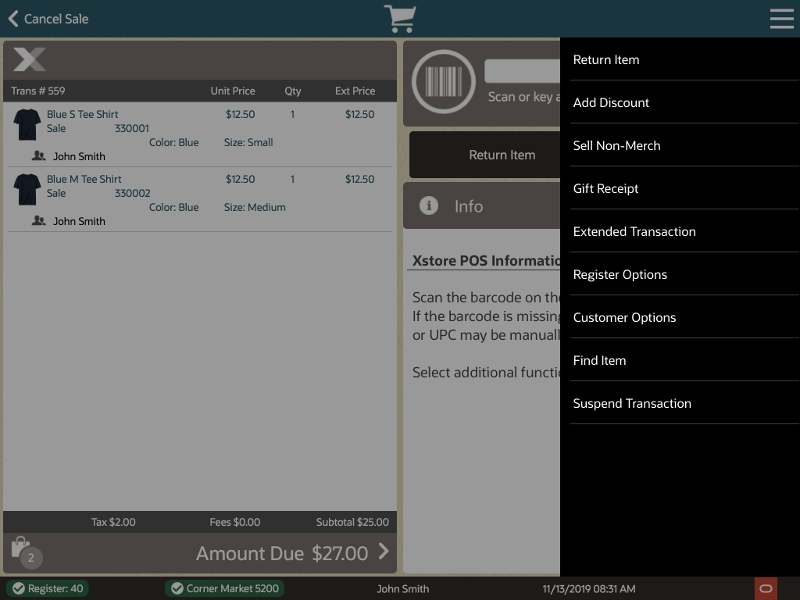
Figure 2-13 Handheld Context Menu - Sale Mode
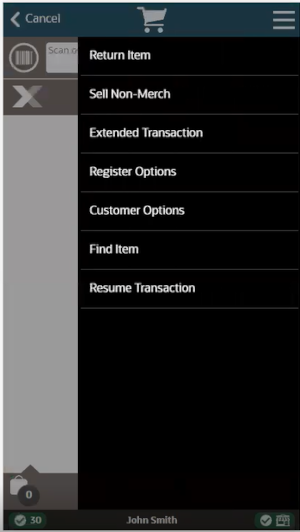
Select the respective option to access the appropriate functionality.
Table 2-3 Tablet Context Menu Options Home Screen - No Login
| Context Menu Option |
|---|
|
Balance Inquiry |
|
Clock in/Out |
|
Customer |
|
Flash Sales |
|
Item Lookup |
|
Price Inquiry |
|
Receipt Reprint Options |
|
About |
Table 2-4 Tablet Context Menu Options Within Sale Mode
| Context Menu Option | Sub-Menu Option |
|---|---|
|
Return Item |
n/a |
|
Add Discount |
|
|
Sell Non-Merch |
Sell Non-Merch |
|
Sell Gift Card |
|
|
Sell Gift Certificate |
|
|
Gift Receipt |
|
|
Extended Transaction |
Order |
|
Send Sale |
|
|
Layaway |
|
|
Special Order |
|
|
Work Order |
|
|
Warranty |
|
|
Pre-Sale |
|
|
Hold |
|
|
Local Inventory Order |
|
|
Register Options |
Balance Inquiry |
|
House Account Payment |
|
|
House Account Reversal |
|
|
Change Trans Tax |
|
|
Add Coupon |
|
|
Redeem Rain Check |
|
|
Assign Gift Registry |
|
|
Lock Register |
|
|
Customer Options |
Assign Customer |
|
Remove Customer |
|
|
View Customer |
|
|
Find Item |
Price Inquiry |
|
Item Lookup |
|
|
Inventory Locator |
|
|
Resume/Suspend Transaction |
n/a |
Selection Menu
A selection menu displays a list of options among which one item can be picked. Selection menus are generally used as part of a set of entry fields within a form.
A closed selection menu displays the option that has been selected (below).
Figure 2-14 Selection Menu Displaying Selected Option
To change the option selected, select the selection menu to display the list of possible options (right), then select the correct option in the list.
Figure 2-15 Selection Menu
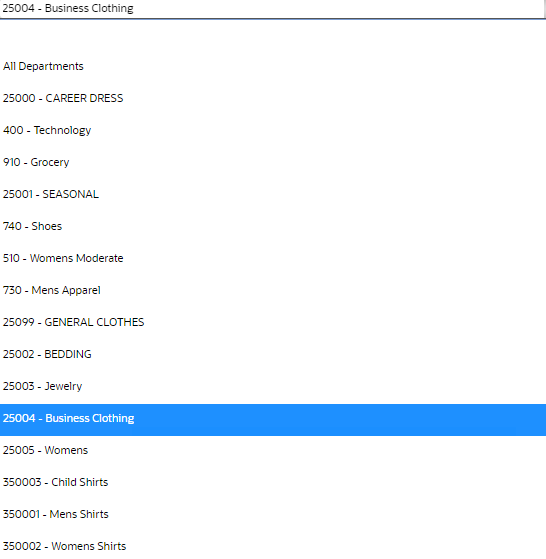
Lists
A list displays a series of items. Each item in the list can be selected to open it.
-
Lists are frequently used to display search results, such as customers returned by a Change Country, or documents returned when you Search for a Receiving Document.
-
Lists are also used for standard menus throughout the Xstore POS application.
Figure 2-16 Example List

Scrolling List /Tabs
This window displays different messages that are selected by the options, and they are equivalent to the tabs at the top of the window on the desktop version of Xstore. Rolling your finger up and down the tab section will give you access to the list selection. Select an option to put it in the focus area. Similarly, the tabs can be swiped left - to - right or vice versa to view each tab. A page indicator towards the bottom of the screen indicates the selected tab.
Figure 2-17 Xstore Tablet Home Screen

In a base implementation, Desktop, Thin Client, and Tablet display the following options:
Orders Tab
The Orders tab provides a list of orders at your store requiring action.
Figure 2-18 Orders Tab
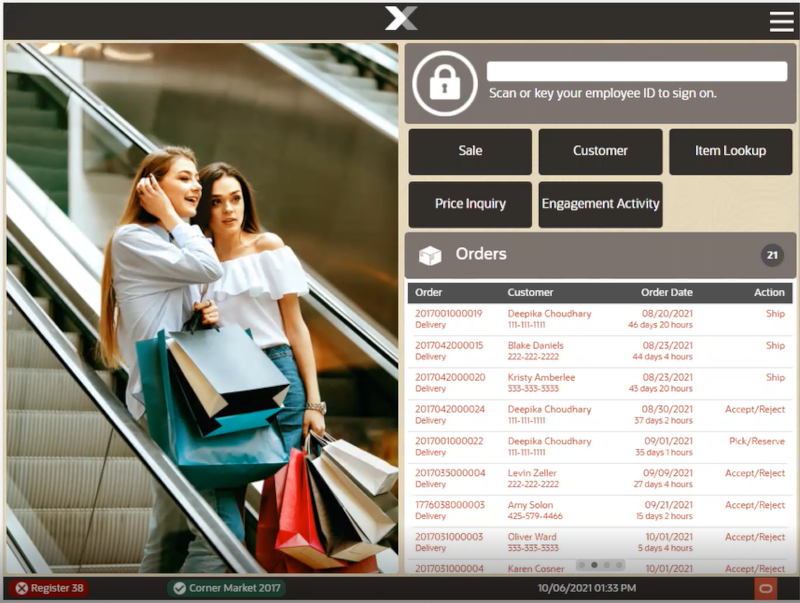
Orders Dashboard
The Orders Dashboard displays the order statistics and is available on Desktop, Thin Client, and Tablet.
Oracle Retail Order Broker Cloud Service is an optional module that can be interfaced with Xstore to provide information about inventory availability across all sales channels.
Figure 2-19 Orders Dashboard

The Orders Dashboard is broken up into four sections – Overview, Customer Activity, Pickup Orders, and Shipment Orders. It represents all Order Broker orders and does not include special orders, local inventory orders and so on.
-
In the Overview section, there are 5 statistics: New Orders, Total Items, Average Age, Oldest Age and Unfulfillable.
-
New Orders - represents all new orders that have come into the store either created at the POS or from the retailer's website on the current day (system date). These new orders have not been touched by an associate (no status changes have been made to any items in the order).
-
Total Items - represents all items in the new orders. For example, if there is one new order with five items the total number of items would be 5.
-
Average Age - is an average age (displayed in days and hours) of all orders (in any status except Picked Up). The clock (age) begins when the order is created, and the clock continues until the item has been picked up by the customer. At customer pick up the ‘clock' stops.
-
Oldest Age - represents the oldest order in the system that has not been picked up by the customer in days and hours. It is not an average but displays the actual age of the oldest order.
-
Unfulfillable - represents the total number of orders in the system that cannot be fulfilled for any number of reasons. For example, the item is not in stock at the store, or it is damaged. This number does not represent items but of orders.
-
-
The Customer Activity section shows the following values:
-
Ready - represents the number of orders that are awaiting a customer to pick up the order. This is the total number of orders, at the store, ready for customer pickup, and not just the orders for the current day.
-
Picked Up - represents all orders, for the current day, that have been picked up by customers.
-
Cancelled - displays the number of orders cancelled at the store for the current day. Orders can be cancelled via order broker or a customer at the store deciding to cancel their order.
-
-
Pickup Orders displays the number of orders in these states:
-
Open - counts all orders that have been polled but not yet reviewed by the store.
-
Accepted - the total number of orders that have been accepted by the store.
-
Ready - displays the total number of orders ready for customer pickup. For example, if there are 2 orders and each order has 3 items and they are all ready for customer pick up, the number displayed by Ready will be 2.
-
Rejected - displays the number of orders where at least one item was Rejected on that day.
-
-
In the Shipment Orders section, the numbers represent those orders that require shipping.
-
Open - displays the number of orders that have not yet been reviewed by the store. The number represents the total number and not just the current day's number of open orders awaiting to be shipped.
-
Accepted - represents all orders that have been accepted by a store associate. Before an order is ready to be shipped, it's items must first be accepted in the store.
-
Ready - displays the number of orders that are ready to be shipped. The items in these orders have been picked and packaged for the next shipment out of the store.
-
Rejected - displays the number of orders where at least one item was rejected on that day.
-
Info Tab
The Info tab may display product-specific information for an item-entry scenario, customer/item detail information for a layaway transaction, or instructions for recording a repair or alteration selection.
Figure 2-20 Default Info Tab Sale Mode

Only one message displays per item in the Info tab. This may be a text message, an image or a composite message (graphic and text). This information may relate to the item directly or to recommend other products that relate to the item being purchased. A couple examples of this would be a customer purchasing a shirt that has a coordinating jacket and tie. These two items, the jacket and tie, could be set up to display on the Information Tab in Xstore for the associate to recommend to the customer. Another example would be the purchase of an item that would require another purchase, for instance a watch that does not come with a battery.
Figure 2-21 Info Tab Showing Item Information
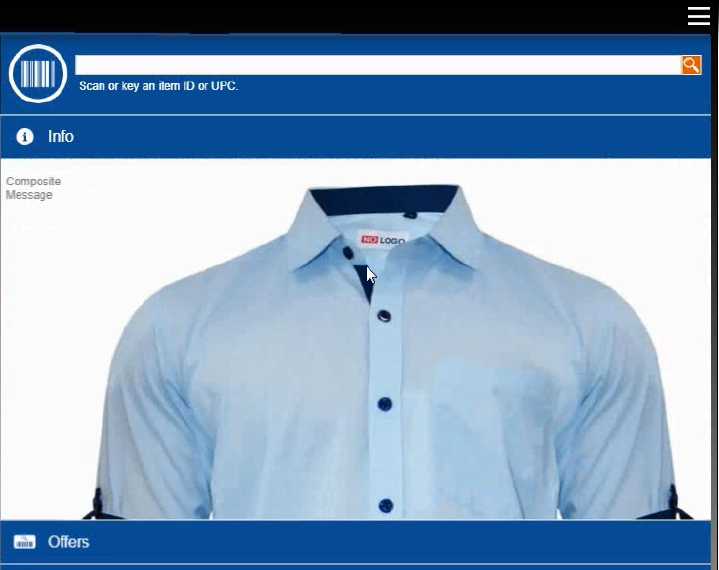
If DisplayMessageAsNotify setting is configured, then multiple item text messages pop up in Xstore during the sales process.
Tasks Tab
The Tasks tab displays open and in progress tasks with start date/time prior to the current date and end date/time equal to the current date or in the future. Tasks shown here are view only.
Figure 2-22 Tasks Tab
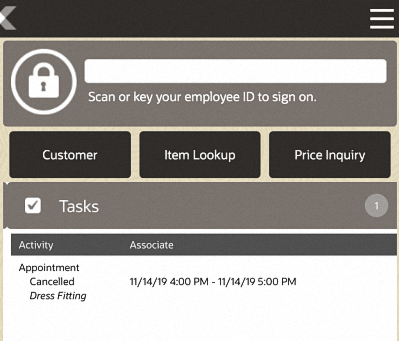
The following information is displayed for each task:
-
Activity - The type, status, and description associated with the task.
-
Associate - The assigned associate, appointment start date and time, and end date and time.
Goals Tab
The Goals tab displays information from the corporate office about the goals set for your store for a specified date range. You are not required to log in to view store goals. These goals are visible to all employees.
The goals are listed in the following order:
-
Completed goals
-
Active goals
-
Future goals
The goals are displays in color, based on their status:
-
Green - Goals completed and met.
-
Red - Goals completed but not met.
-
Black - Active, current, and future goals.
Each goal has an effective date and an end date. The store goal is shown in the Goal column and the current amount achieved toward the goal is shown in the % To Date column.
Note:
Future goals display “N/A"' in the % To Date column until they become active.
Sales Goal to date progress is calculated using net sales. Progress toward store goals can also be found in the Store Goals report and on the Dashboard.
Messages Tab
You are not required to log in to view messages. These messages are visible to all employees. The information shown on the Messages tab may be from the corporate office, or from your store management.
Messages require no action and may be store-specific (only displayed in your store, not corporate-wide) or register-specific (only displayed on a designated register).
These messages are time-based and do not display after the expiration date has passed.
Note:
If the message contains a URL, click the link icon to open the URL.
Messages use icons to indicate priority:
-
Exclamation Point - High priority
-
No icon - Medium priority
-
Down Arrow - Low Priority
Figure 2-23 Messages Tab

Local Inventory Orders and Send Sale Transactions tendered with Pay By Link (Customer Not Present) that are awaiting payment are listed in this tab. The sales that are voided due to the PBL expiring are also listed.
Offers Tab
Offers Tab: The Offers tab displays e-awards, coupons and entitlements that are available and whether they have been applied to the transaction. When a customer is linked to a transaction, the number of offers is displayed. As qualifying items are added to the transaction, entitlements are automatically applied to the basket. Coupons need to be scanned or entered to be applied to the transaction. The different offer types are represented by distinguishing icons on both the offers tab and the sales display panel.
The following information is displayed for each offer:
-
Offer ID - ID for the e-award, coupon or entitlement.
-
Description - Description of the coupon.
-
Expires - Expiration of offer.
-
Applied? - Indicates whether the coupon has been applied to the transaction.
If a customer decides they do not want to use an offer for that transaction, it can be removed manually. To remove an offer, select the discount from the sales display panel and void the line from the transaction. The offer shows as canceled under the applied column.
Status Bar
The status bar is shown on the bottom of the screen. It is divided into several parts, each displaying information about the system.
The status bar has the following organization:
Tablet and Thin Client
Figure 2-24 Tablet Status Bar
-
On the left, the register number and whether the register is open or closed.
-
If the register is open, the first indicator will be green and a check mark next to it.
-
If the register is closed, the first indicator will be red and a cross (x) next to it.
-
-
Next to it is the store name, number, and whether the store is currently open or closed.
-
If the store is open, the first indicator will be green and a check mark next to it.
-
If the store is closed, the first indicator will be red and a cross (x) next to it.
-
-
In the center, the name of the logged-in user. If no user is currently logged in, nothing will be displayed in the middle.
-
On the right, Xstore POS displays the business date and time, and the Oracle logo. Tapping the Oracle logo takes you to the About Information page.
Handheld
Figure 2-25 Handheld Status Bar
-
On the left, the register number and whether the register is open or closed.
-
If the register is open, the first indicator will be green and a check mark next to it.
-
If the register is closed, the first indicator will be red and a cross next to it.
Tapping the red register indicator (only works when you are not logged in) launches the security prompt (to login and enter credentials). The following Register Open prompt allows you to open the register without the need to follow the menu options.
-
-
In the center, Xstore POS displays the business date. This switches over to the user name when a user logs into the device.
-
On the right, Xstore POS displays the status of the store, whether it is open (green) or closed (red).
Date/Time Picker
The Date/Time Picker is used on all date entry fields in the Xstore POS. Select the Month, Day and Year as required.
Figure 2-26 Tablet Date Picker Example
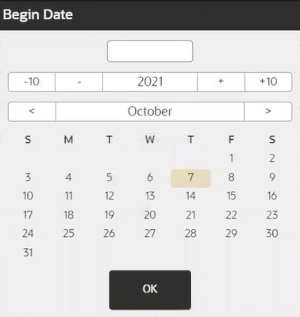
Figure 2-27 Handheld Date Picker
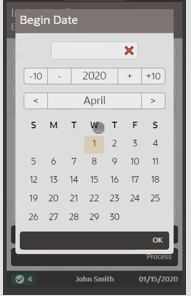
For times, select the Hour, Minute and AM/PM as required.
Figure 2-28 Tablet Time Picker Example
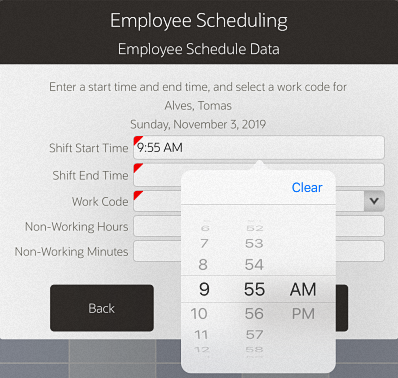
iOS Status Bar
Available for iOS mobile devices only, the status bar is displayed at the top of the mobile and shows:
-
Battery life
-
WiFi connection status
Figure 2-29 iOS Status Bar

Note:
The details of the information displayed on the status bar is dependent on the settings (under Settings) on the iOS device. For example, battery percentage can be turned off and will not display in the status bar.
Required Fields
Required fields are underlined for distinction on Xstore Handheld, Tablet, and Thin Client.
Figure 2-30 Required Fields
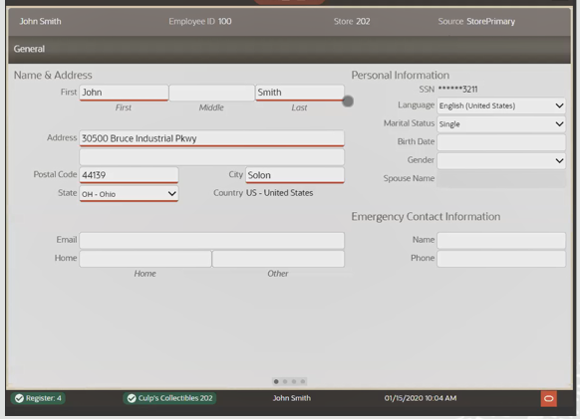
Search Menu Option
From the Main Menu you can quickly navigate to the menu option needed on the Xstore Handheld, Tablet, and Thin Client. Start typing in the search bar and the Xstore POS intuitively shows matches. Select the function required.
Figure 2-31 Handheld - Search Menu Option
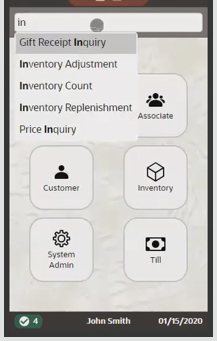
Figure 2-32 Tablet - Search Menu Option
